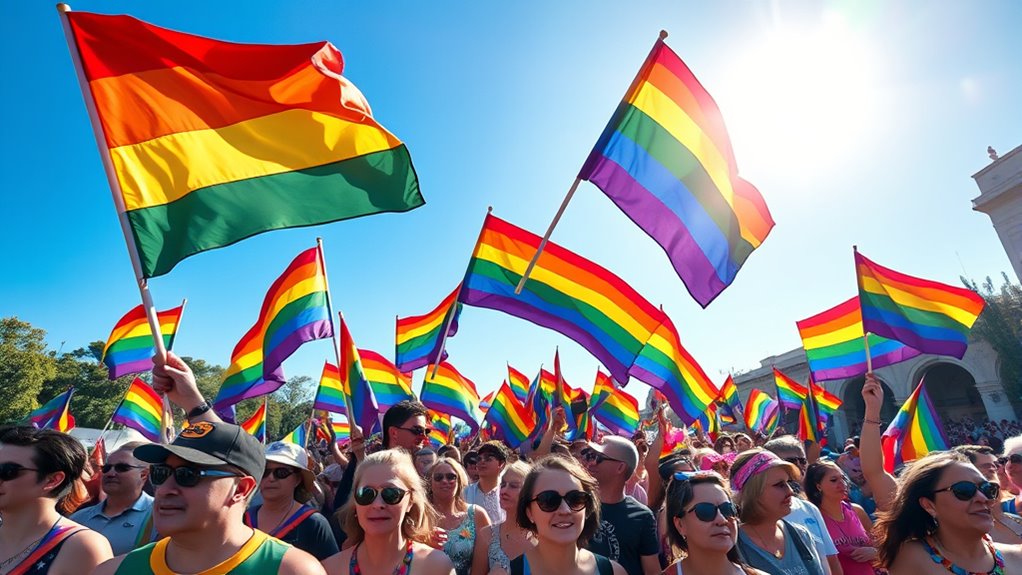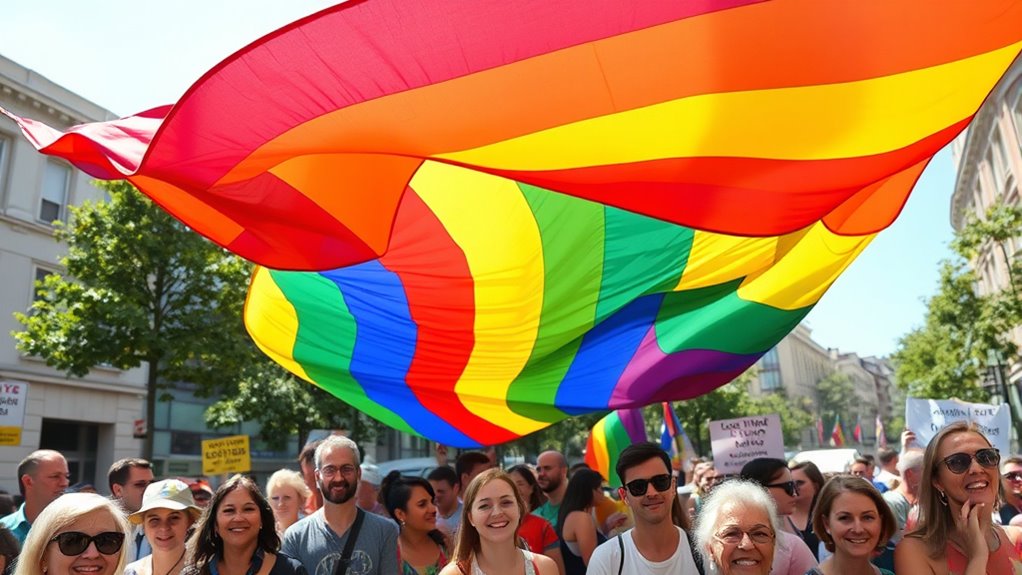In LGBTQ+ activism, the rainbow’s colors symbolize diversity, pride, and unity. Red stands for life, orange for healing, yellow for energy, green for nature, blue for harmony, and purple for spirit. Each hue represents a different aspect of the community’s experiences and hopes. These colors serve as a powerful visual reminder of the ongoing fight for equality and acceptance. If you explore further, you’ll discover even deeper meanings behind each shade and their cultural significance.
Key Takeaways
- The rainbow flag features six colors, each representing different aspects like life, healing, and spirit.
- Red symbolizes life, highlighting vitality and passion within LGBTQ+ communities.
- Orange stands for healing, emphasizing recovery and well-being.
- Yellow represents sunlight and energy, symbolizing happiness and hope.
- Green signifies nature and growth, reflecting renewal and harmony.

The rainbow has become a powerful symbol of LGBTQ+ activism, representing diversity, pride, and the fight for equality. Its vibrant colors serve as a visual reminder of the broad spectrum of identities and experiences within the community. The use of the rainbow as a symbol isn’t arbitrary; it carries deep historical symbolism that connects current activism to earlier movements advocating for civil rights and social acceptance. Historically, the rainbow was seen as a symbol of hope and unity, a natural phenomenon that embodies the idea of harmony amidst diversity. Over time, it was adopted by LGBTQ+ activists to symbolize inclusion and the breaking down of societal barriers. The rainbow’s multiple colors reflect the idea that no single identity defines the community; instead, it’s the collective strength of diverse individuals standing together. Additionally, the rainbow can serve as a symbol of emotional healing, emphasizing its significance beyond mere representation.
Cultural variations reveal that the rainbow’s significance isn’t uniform across all societies. While in Western contexts, the rainbow is often linked directly to LGBTQ+ pride, other cultures have their own interpretations. For example, some Indigenous cultures in North America view rainbows as sacred symbols of spiritual connection and renewal. In certain Asian traditions, rainbows are symbols of good fortune and harmony, often representing balance in the universe. These cultural variations highlight that the rainbow’s symbolism is fluid and adaptable, shaped by historical context and societal values. Recognizing this diversity enhances your understanding of the rainbow’s universal appeal while appreciating its specific cultural meanings.
As you explore the significance of the rainbow in LGBTQ+ activism, it’s essential to understand that its colors aren’t just visually striking—they convey messages of resilience, acceptance, and community. Each color has its own story and symbolism. For instance, red signifies life, orange stands for healing, yellow embodies sunlight and energy, green represents nature, blue signifies harmony, and purple symbolizes spirit. These hues work together to create a collective narrative that celebrates individuality while emphasizing unity. The rainbow’s historical symbolism and cultural variations deepen its meaning, reminding you that the fight for equality is rooted in shared human experiences across different societies. Its vibrant spectrum encourages you to embrace diversity, foster understanding, and stand in solidarity with others fighting for their rights.
Frequently Asked Questions
How Did the Rainbow Flag Originate Within Lgbtq+ Activism?
You should know that the rainbow flag originated in LGBTQ+ activism as a symbol of hope and diversity. Created by Gilbert Baker in 1978, it drew inspiration from historical flag symbolism and the cultural adoption of the rainbow as a sign of unity. The flag’s bright colors quickly became a powerful visual statement, helping to promote awareness and acceptance within the community and beyond.
Which Color in the Rainbow Flag Represents Sexuality or Gender?
You’ll find that the pink stripe in the rainbow flag represents sexuality, highlighting sexual identity. The red stripe symbolizes life, while the orange reflects healing and vigor. The yellow stands for sunlight and energy, and the green signifies nature and growth. Blue denotes harmony and peace, and purple represents spirit. Each color collectively celebrates diverse gender expressions and sexual identities, empowering you to embrace your authentic self within the vibrant LGBTQ+ community.
Are There Other Symbols Associated With Lgbtq+ Pride Besides the Rainbow?
You’ll be amazed at how many symbols express LGBTQ+ pride beyond just the rainbow. Pride symbols like the pink triangle, lambda, and the transgender symbol carry powerful histories and meanings. Alternative flags, such as the bisexual, pansexual, and asexual flags, celebrate diverse identities. These symbols and flags create a vibrant tapestry of identity, allowing everyone to find a visual voice that truly resonates with their unique journey and community.
How Have Rainbow Colors Influenced Global Lgbtq+ Rights Movements?
Rainbow colors have profoundly influenced global LGBTQ+ rights movements by serving as powerful symbols of unity and pride. You see, their historical symbolism represents diversity and inclusion, inspiring activism worldwide. Cultural interpretations vary, but the rainbow remains a universal sign of hope and acceptance. When you wear or display rainbow symbols, you actively promote awareness, solidarity, and the ongoing fight for equal rights across different societies.
What Are the Variations of Rainbow Flags Used Worldwide?
The rainbow flag is a chameleon, changing to reflect diverse cultural symbolism worldwide. You’ll find variations like the Philadelphia Pride Flag, which adds black and brown stripes, and the Progress Pride Flag with inclusive colors. These flag variations symbolize different identities and struggles, making each one a unique emblem of acceptance. By embracing these differences, you help expand the rainbow’s message of unity, love, and diversity across all communities.
Conclusion
As you see the vibrant rainbow, remember it’s more than just colors—it’s a symbol of hope, struggle, and pride. While the hues seem cheerful and bright, they represent battles fought in silence and loud protests alike. The rainbow’s beauty contrasts with the challenges faced by the LGBTQ+ community. So, next time you glance at it, reflect on the strength behind each shade, and realize that behind every color lies a story worth fighting for.









